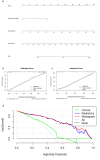Prediction of soft tissue sarcoma grading using intratumoral habitats and a peritumoral radiomics nomogram: a multi-center preliminary study
- PMID: 39723369
- PMCID: PMC11668965
- DOI: 10.3389/fonc.2024.1433196
Prediction of soft tissue sarcoma grading using intratumoral habitats and a peritumoral radiomics nomogram: a multi-center preliminary study
Abstract
Background: Accurate identification of pathologic grade before operation is helpful for guiding clinical treatment decisions and improving the prognosis for soft tissue sarcoma (STS).
Purpose: To construct and assess a magnetic resonance imaging (MRI)-based radiomics nomogram incorporating intratumoral habitats (subregions of clusters of voxels containing similar features) and peritumoral features for the preoperative prediction of the pathological grade of STS.
Methods: The MRI data of 145 patients with STS (74 low-grade and 71 high-grade) from 4 hospitals were retrospectively collected, including enhanced T1-weighted and fat-suppressed-T2-weighted sequences. The patients were divided into training cohort (n = 102) and validation cohort (n = 43). K-means clustering was used to divide intratumoral voxels into three habitats according to signal intensity. A number of radiomics features were extracted from tumor-related regions to construct radiomics prediction signatures for seven subgroups. Logistic regression analysis identified peritumoral edema as an independent risk factor. A nomogram was created by merging the best radiomics signature with the peritumoral edema. We evaluated the performance and clinical value of the model using area under the curve (AUC), calibration curves, and decision curve analysis.
Results: A multi-layer perceptron classifier model based on intratumoral habitats and peritumoral features combined gave the best radiomics signature, with an AUC of 0.856 for the validation cohort. The AUC of the nomogram in the validation cohort was 0.868, which was superior to the radiomics signature and the clinical model established by peritumoral edema. The calibration curves and decision curve analyses revealed good calibration and a high clinical application value for this nomogram.
Conclusion: The MRI-based nomogram is accurate and effective for predicting preoperative grading in patients with STS.
Keywords: grade; habitats; nomogram; radiomics; soft tissue sarcoma.
Copyright © 2024 Wang, Guo, Zhang, Huang, Duan, Huang, Xu and Wang.
Conflict of interest statement
Author CH was employed by the company Beijing Deepwise and League of Philosophy Doctor PHD Technology Co., Ltd. The remaining authors declare that the research was conducted in the absence of any commercial or financial relationships that could be construed as a potential conflict of interest.
Figures



Similar articles
-
Intratumoral and peritumoral MRI-based radiomics prediction of histopathological grade in soft tissue sarcomas: a two-center study.Cancer Imaging. 2023 Oct 26;23(1):103. doi: 10.1186/s40644-023-00622-2. Cancer Imaging. 2023. PMID: 37885031 Free PMC article.
-
Magnetic Resonance Imaging-Based Radiomics Nomogram for Prediction of the Histopathological Grade of Soft Tissue Sarcomas: A Two-Center Study.J Magn Reson Imaging. 2021 Jun;53(6):1683-1696. doi: 10.1002/jmri.27532. Epub 2021 Feb 18. J Magn Reson Imaging. 2021. PMID: 33604955
-
MRI-based intratumoral and peritumoral radiomics for preoperative prediction of glioma grade: a multicenter study.Front Oncol. 2024 May 13;14:1401977. doi: 10.3389/fonc.2024.1401977. eCollection 2024. Front Oncol. 2024. PMID: 38803534 Free PMC article.
-
T2WI-based MRI radiomics for the prediction of preoperative extranodal extension and prognosis in resectable rectal cancer.Insights Imaging. 2024 Feb 27;15(1):57. doi: 10.1186/s13244-024-01625-8. Insights Imaging. 2024. PMID: 38411722 Free PMC article.
-
Research progress in multimodal radiomics of rectal cancer tumors and peritumoral regions in MRI.Abdom Radiol (NY). 2025 May 31. doi: 10.1007/s00261-025-04965-1. Online ahead of print. Abdom Radiol (NY). 2025. PMID: 40448847 Review.
Cited by
-
Differentiating Lung Adenocarcinoma from Tuberculous Nodules in HIV/AIDS Patients Using Preoperative CT-Based Intratumoral and Peritumoral Radiomics Combined with Clinical Features.J Multidiscip Healthc. 2025 May 12;18:2693-2706. doi: 10.2147/JMDH.S524527. eCollection 2025. J Multidiscip Healthc. 2025. PMID: 40384812 Free PMC article.
-
Integrating radiomics, artificial intelligence, and molecular signatures in bone and soft tissue tumors: advances in diagnosis and prognostication.Front Oncol. 2025 Aug 18;15:1613133. doi: 10.3389/fonc.2025.1613133. eCollection 2025. Front Oncol. 2025. PMID: 40900793 Free PMC article.
References
-
- Sundby Hall K, Bruland ØS, Bjerkehagen B, Zaikova O, Engellau J, Hagberg O, et al. . Adjuvant chemotherapy and postoperative radiotherapy in high-risk soft tissue sarcoma patients defined by biological risk factors-A Scandinavian Sarcoma Group study (SSG XX). Eur J Cancer. (2018) 99:78–85. doi: 10.1016/j.ejca.2018.05.011 - DOI - PubMed
LinkOut - more resources
Full Text Sources

